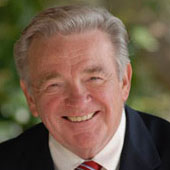Southern California: A Diversity Laboratory
What makes this region such a driving force in the United States?
May 16, 2009
Southern California is primed to demonstrate the advantages of cultural diversity to the whole United States.
This will be a significant contribution to the nation. Many regions seem to be caught up in a swirl of angry rhetoric over illegal aliens that sometimes veers into hostility toward all immigrants.
For the most part, this is not true of Southern California, which has more immigrants than any other region. Early in this decade, Los Angeles County had more foreign-born residents than anywhere in the country — more than 30% of its population — and neighboring counties also had high numbers.
These percentages have been declining in recent years, as relatively fewer immigrants are coming to the region. But the diversity in the region's future is arresting when one looks at figures from the state government, which lumps diverse peoples into the categories: "white," "Hispanic," "Asian and "black."
For example, by 2010 Los Angeles County is expected to have a mix of 2.9 million people classed as white, 5.1 million Hispanic, 1.4 million Asian — and 870,000 black, according to projections by the California Department of Finance.
Orange County in 2010 will be closely divided between 1.4 million whites and 1.2 million Hispanics. And by 2020 Hispanics will he the largest ethnic group in Orange County. In Riverside and San Bernardino counties, they will constitute about half the population of San Diego County.
So yes, Southern California is ideally suited to teach the rest of the United States about ethnic and cultural diversity. The truth about the region is that it now looks the way America will look in the near future as numbers of immigrants and their offspring increase throughout the country. But this future is not like America's past.
The Population Dynamics Research Group at the University of Southern California notes that Southern California's ethnic groups are not ghettoizing over generations, as ethnic peoples did in past centuries in New York, Boston and Chicago. Rather, they are moving up in status and often moving on from their original homes in neighborhoods of Los Angeles and Orange County to spread throughout the region and neighboring states.
And the research found that newcomers these days are, on the whole, better off than new immigrants and their families during previous decades. To say this is not to deny the hardships of uncertain and low-wage work — and people's struggles to adapt and raise children among street gangs and countless pitfalls. But with all the problems of poor areas, no place in the vast expanse of Southern California is simply a depressed environment, visibly without hope.
There is an energy in the region, an imagination in its charities as much as in its innovative businesses.
The deeper lesson of Southern Ca1ifornia's diversity — and that of the United States (with Latinos becoming the large minority in 27 states in 2008) — is that this diversity is not sparking large-scale confrontation and strife. Even on the bitter issue of illegal aliens, the majority of Southern Californians — and a majority of all Americans — want an immigration solution to be worked out, including paths to citizenship for people who came here to work years or decades ago.
Today's arguments are nothing compared with the vicious anti-Asian riots of nineteenth-century Los Angeles or the anti- Mexican prejudice of more recent times. To gauge the current temperature, just glance at the municipal leadership of any of the more than 200 separately incorporated cities in Southern California.
In heavily Asian immigrant cities like San Gabriel, one finds a Gutierrez serving on the city council with a Huang. In Anaheim's city council, a Pringle serves with a Hernandez and a Sidhu. A decentralized abundance of incorporated communities makes for opportunities to run City Hall.
And the numbers of officials from new ethnic groups grows with every election, as happened in 2007 when Janet Nguyen, a Vietnamese American, was elected one of Orange County's five supervisors.
For a closer view of Southern California as role model for the United States, look at a signal event that occurred in 2005: The election of Antonio Villaraigosa as mayor of Los Angeles. Villaraigosa is the first Latino mayor of Los Angeles in 133 years — or since the days of ranchero culture in the city — and his election was hailed nationwide as a turning point for Latino political power and cultural acceptance.
The truth about future immigration in California and the United States is the same as it was in the past. People do not come to the United States to fail, to be half-hearted.
To sum up the question of diversity and the region's meaning for the entire country, I turn to Kevin Starr, professor of history at USC, former state librarian and author of ten works about California history. "If and when the United States wanted to see and know itself as a successful world commonwealth, an ecumenopolis, all it had to do was to look to California as it remained the coast of dreams," he says.
This conclusion is as true today as it will be tomorrow.
Reprinted with permission from Stanford University Press. Copyright 2009 James Flanigan.
Takeaways
In heavily Asian immigrant cities like San Gabriel, one finds a Gutierrez serving on the city council with a Huang.
Early in this decade, Los Angeles County had more foreign-born residents than anywhere in the country — more than 30% of its population.
Southern California's ethnic groups are not ghettoizing over generations, as ethnic peoples did in past centuries in New York, Boston and Chicago.
Read previous
The Vegas Dilemma and Failed States
May 15, 2009
